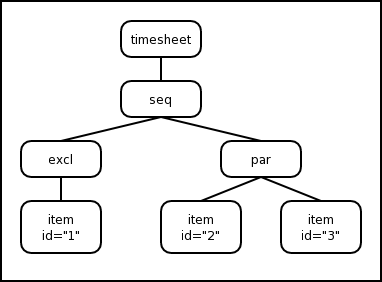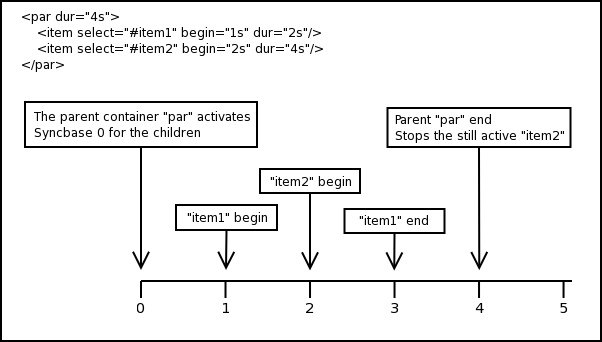This section is normative.
This section defines the elements and attributes that make up the functionality in the SMIL BasicTimesheets module.
13.3.1 Elements and Attributes
The SMIL 3.0 BasicTimesheets module defines two elements that provide basic support for timesheets mark-up for XML presentations.
The elements defined in this module are:
The attributes defined in this module are:
The timesheet element
The timesheet element defines a parent container for the par, seq, excl, and item SMIL Timesheet elements of the timing language.
Element Attributes
The timesheet element defines the following attributes:
- src = CDATA
- The value of src tells the location of an external timesheet, which will be appended to the end of the local timesheet. With this attribute a common timesheet can be reused in multiple documents.
- media = CDATA
- The media attribute is used for selecting the most suitable timesheet for current media device. It works similarily to the @media rule in the CSS stylesheets [CSS2].
Element Content
The timesheet element contains one or more par, seq, excl, and item SMIL Timesheet elements of the timing language.
The par element
The par Parallel time container. All the children of the par are activated simultaneously and the duration of the container, if not specified with the dur attribute will be the same as with the child that has the longest duration of all the children of the container. This element is similar to the par element specified in the SMIL 3.0 Timing and Synchronization Module.
Element Attributes
This elements accepts the standard set of SMIL timesheet attributes. Profiles integrating SMIL Timesheets may specifiy other attributes for this element.
Element Content
The par element contains one or more par, seq, excl, and item SMIL Timesheet elements of the timing language.
The seq element
The seq Sequential time container. The children of seq are displayed sequentially so, that next child is activated as soon as the previous child finishes. The first child is activated when the parent container starts. Only one child of seq can be shown simultaneously. Total duration of the seq is either specified by the dur attribute, or if it is omitted, by the sum of durations of all the children of the element. If a child of the container has an indefinite duration, the following children will never be activated and the duration of the container will be indefinite. This element is similar to the seq element specified in the SMIL 3.0 Timing and Synchronization Module.
Element Attributes
This elements accepts the standard set of SMIL timesheet attributes. Profiles integrating SMIL Timesheets may specifiy other attributes for this element.
Element Content
The seq element contains one or more par, seq, excl, and item SMIL Timesheet elements of the timing language.
The excl element
The excl Exclusive time container. The exclusive time container can have only one child active at a certain moment, similarly to the sequential time container. The excl doesn't provide any other synchronization or scheduling to its children, it only assures that no multiple children are active simultaneously. When a child starts according to its begin attribute, the container deactivates any other child that may be active.
Unlike the other time containers, excl has implicitely indefinite duration, since there is no defined situation when the container should end. The par ends when all the children has stopped, and the seq when the last child finishes. Neither approach is applicable to the excl, since the temporal order of the children is unknown.
The excl is a special case of the seq where the container's duration is set to indefinite and all the children have indefinite or interactive begin times. It is also a simplified version of the excl element defined in the SMIL 3.0 Timing and Synchronization Module.
Element Attributes
This elements accepts the standard set of SMIL timesheet attributes. Profiles integrating SMIL Timesheets may specifiy other attributes for this element.
Element Content
The excl element contains one or more par, seq, excl, and item SMIL Timesheet elements of the timing language.
The item element
The item target element reference element. The item element implements the actual connection between the timesheet and the document. It can reference a media element or a set of elements by the element's tag, id or class; the syntax and processing is similar to the CSS selector syntax.
Element Attributes
The item element defines the following attributes:
- select = CDATA
- The select attribute links the timesheet to the document. The attribute follows the same syntax and processing as the CSS selectors, so that the elements can be referenced by their name, id or class, or a more complex combination of the selectors. If the attribute targets multiple elements in the document, item controls all of them. The attribute value can also specify a comma separated list of selectors.
- prefetch = CDATA
- The prefetch controls the loading of the resources needed by the elements referenced by the item element. Some resources, like audio, video and big images, can be quite big in size and fetching them on the fly while the timesheet is already running could skew the timing of the whole timesheet. With the prefetch attribute the author can mark certain elements and their resources to be prefetched to the memory before the timesheet is started. This way the resources can be shown precisely at the specified moment of time. If the attribute is omitted or set to false, the resources are loaded just before the item is activated. When the attribute is set to true the resources are loaded into the memory before the timesheet and the timeline is started.
Element Content
This element is empty.
13.3.2 Event Model
The begin and dur attributes can contain
references to DOM events [DOM2Events]. DOM events can be triggered by user
interaction or by some other event in the document. Events are divided into
two distinct groups, internal events and user events.
Internal events
Internal events are dispatched from within the timesheets. They can be used by other elements in the timesheet to create relations between different parts of the timeline. The events specified are begin event, which is dispatched when an element starts and end event, which is dispatched when element stops.
User events
User events are triggered by the actions that user makes. A typical example is that the user clicks on a link in the document, and thus a DOMActivate event is dispatched [DOM2Events].
Event semantics
A timesheet element is set to listen to a certain event by specifying the
event's target and type by either begin or dur
attribute. When specified by the begin attribute, an inactive or
active but not yet started element will be started when it receives the
specified event. This may involve the activation and starting of the parent
elements as well, which can require some special scheduling to be done on the
upper level of the DOM tree. Consider Figure 2
as an example. At a certain time, the item with the id "1" is
active. This means that the second child of the seq (i.e., the
par element) can't be active. Next, the item number
"3" gets an event, which it is set to listen to by the begin
attribute. To activate itself, the element must first inform its parent that
it is going to start. The parent (i.e., the par element) is also
inactive, so it informs its parent of the activation. The parent
seq element then stops the excl element and its
children to allow the par element to start, and par
element then activates its children according to the definition.

Figure 2: the affect of event on a timesheet.
When the element is specified to stop according to an event, it doesn't cause that much processing in the timesheet. The element informs its parent that it has stopped and parent then decides what should happen next. Of course, some other element could be waiting to start according to the end event from the particular element.
Additional events
There are also four additional events that are specified for the
seq element. They are select-next,
select-prev, select-first and select-last. These
are used to select a certain child of the seq element, which
facilitates the creation of presentations where the user can have control of
the progression of the timeline, for example, a slide show. It should be
possible to add later more additional events to any other elements of the
timesheet.
